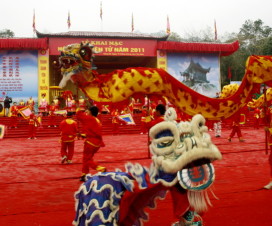My uncle Quan, who was an ornamental tree planter and dealer in the southern province of Binh Duong, took me to visit the renowned Cai Mon Flower Village of Cho Lach District in the province of Ben Tre last weekend.
The dusty road from Chau Phu ferry to the flower village was made more pleasant thanks to hundreds of different kinds of bonsai, arranged in rows along the roadside. From afar, I could see the front yards of homes lined with pots of mai (apricot blossoms), marigolds and cockscomb, which will come into glorious bloom during Tet (February 2-6).
We stopped at the house of Trinh Tan Hai, renowned bonsai dealer who specializes in growing kieng la (leaf bonsai).
Hai’s wife, Dang Thi Thu Huong, whose siblings are longtime bonsai planters, said that planting bonsai and other ornamental trees began in Vietnam over 100 years ago.
Now, 90 percent of families in the village are in the bonsai business. Together with Sa Dec Flower Village in Dong Thap Province, Cai Mon Flower Village is one of the two hubs to supply bonsai throughout the country, as well as for export to South Korea and Taiwan.
The house is filled with different kinds of kieng la, yet, according to Hai, these are just a few of the display items.
We had to go three kilometers more before reaching the house of Nguyen Thi Nga, a bonsai and ornament tree artisan in Vinh Thanh Ward of Cai Mon.
She welcomed us in her bare feet to her garden, which even at six hectares feels cramped as it is filled to the brim with different kinds of bonsai, including sago palm, lucky bamboo and daisy. She has even piled plants inside her house and built shelves to hang thousands of lan so (dischidia pectinoides), cultivated in big shells.
Pointing to rows of dai phat tai (great lucky plant) with a single red flower blooming in the center of the tree, Nguyen Thi Nga, who has cultivated bonsai for six years, said, “These and others have all been bought already, it’s a bestseller this year. I’m getting lan so ready for Valentine’s Day on February 14 because of its heart-shaped leaves.”
“Nga’s plants always sell out because she is among the few artisans who can bring dai phat tai to full bloom. I asked her to teach us but she refuses, even after we threatened to kidnap her 18-year old daughter,” Trinh Tan Hai said as he and Nga burst out laughing.
“Like other ornamental plants for the Tet holiday, I have to give them special treatment starting two to three months ago to be able to get them to bloom on time.
“The dai phat tai is among the most difficult to cultivate, but then its flower blooms for up to six months at a time,” said Nga, who seems filled with joy while looking at her beloved trees.
Huong says the job requires not only time and effort, but also a healthy dose of passion. Indeed, 36- year-old Nga has a head full of white hair. She said while preparing trees for Tet, they have to cultivate and prepare baby plants for next year. This requires them to wake up every morning at 1 a.m. to fertilize and trim the trees, and maintain the nylon roof protecting the trees from out of season rains.
Dai phat tai purchased directly at the garden by go-betweens costs just US$5-6 each normally, but the prices rise to $20-25 during Tet, Nga said.
She told us that if we had come to town even a week or ten days later, we would not have been able to see many of the beautiful trees, for they would have been shipped off to other places by then.
“See you at the Tet market in Binh Duong Province,” she told us. She has brought her plants to sell at the Thu Dau Mot market in the province for years now.
I wouldn’t miss it for the world.




